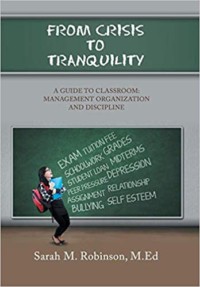Title: From Crisis to Tranquility: A Guide to Classroom: Management Organization and Discipline
Author: Sarah M Robinson, M.Ed
Publisher: Xlibris
ISBN: 978-1-7960-4909-1
Genre: Schools & Teaching
Pages: 151
Reviewed by: Allison Walker
Pacific Book Review
Teacher burnout can be a real problem. Without the resources they need to effectively manage their classroom, teachers may feel overwhelmed and helpless. In her book, From Crisis to Tranquility: A Guide to Classroom: Management Organization and Discipline, author Sarah M. Robinson addresses one of the major causes of teacher burnout: poor classroom management. Whether by ineffective classroom techniques, lack of administrative support, or inability to engage with parents, Robinson’s book is a short but stout guide to evaluating and optimizing your classroom.
From Crisis to Tranquility offers a high level of detail. After all, even the smallest piece of equipment can profoundly affect your classroom, Robinson explains. For example, placing wastebaskets or pencil sharpeners in high traffic areas can congest the flow of the room. If you can’t orient student desks away from windows, you should place a poster over the window to decrease the likelihood of students becoming distracted. When it comes to running the classroom, Robinson understands teaching is not a one size fits all approach. She offers educators a handful of different concepts to consider; for example, assertive discipline and positive discipline may each have their place in the classroom, but it’s up to the teacher to know when and how to use each. Instead of telling educators what to do, Robinson challenges teachers and administrators alike to ask themselves two questions: What am I doing that I should not be doing, and what am I not doing that I should be doing?
If Robinson’s goal is to condense necessary information into one easy to read resource, she succeeds in the job effortlessly. From Crisis to Tranquility is short, to the point, and most importantly, equally as well organized as your classroom will be after you read it. It’s a much more realistic option for a person with a full-time job to consume and refer to. The chapters are clearly labeled and pulling specific information from its pages is easy to do. From understanding student misbehavior, to setting up your classroom to encourage good behavior, any person could open this book and find what they’re looking for.
Although From Crisis to Tranquility primarily addresses grade school classrooms, as an adult educator outside a traditional classroom setting, I still found the basic principles of this book to be useful and rewarding. How you present yourself as a teacher defines your relationship with your students. Even a trick so simple as modeling the behavior your wish to see, which Robinson recommends, has an impact on how all people react to you. So, while From Crisis to Tranquility mainly refers to young students in traditional classroom settings, it should still be considered a viable resource for any person in the education profession.


